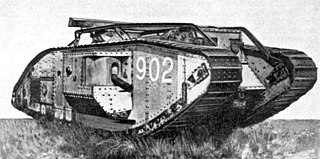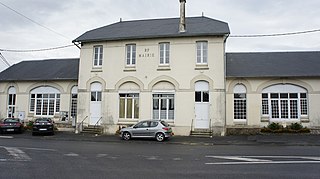
The history of the tank begins with World War I, when armoured all-terrain fighting vehicles were introduced as a response to the problems of trench warfare, ushering in a new era of mechanized warfare. Though initially crude and unreliable, tanks eventually became a mainstay of ground armies. By World War II, tank design had advanced significantly, and tanks were used in quantity in all land theatres of the war. The Cold War saw the rise of modern tank doctrine and the rise of the general-purpose main battle tank. The tank still provides the backbone to land combat operations in the 21st century.

The Renault FT was a French light tank that was among the most revolutionary and influential tank designs in history. The FT was the first production tank to have its armament within a fully rotating turret. The Renault FT's configuration became and remains the standard tank layout. Consequently, some armoured warfare historians have called the Renault FT the world's first modern tank.

The Schneider CA 1 was the first French tank, developed during the First World War.

The Saint-Chamond was the second French tank to enter service during the First World War, with 400 manufactured from April 1917 to July 1918. Although not a tank by a strict definition of a heavily armoured turreted vehicle, it is generally accepted and described as such in accounts of early tank development. It takes its name from the commune of Saint-Chamond where its manufacturers Compagnie des forges et aciéries de la marine et d'Homécourt (FAMH) were based.

The Char 2C, also known as the FCM 2C, was a French post WWI heavy tank landship, later considered a super-heavy tank. It was developed during World War I but not deployed until after the war. It was, in total volume or physical dimensions, the largest operational tank ever made.

The Automitrailleuse de Reconnaissance Renault Modèle 1933 was a French light cavalry tank developed during the Interbellum and used in the Second World War.
Jean Baptiste Eugène Estienne was a general of artillery and a specialist in military engineering, one of the founders of modern French artillery and French military aviation, and the creator of the French tank arm. He is considered by many in France to be the Père des Chars.

The development of tanks in World War I was a response to the stalemate that developed on the Western Front. Although vehicles that incorporated the basic principles of the tank had been projected in the decade or so before the War, it was the alarmingly heavy casualties of the start of its trench warfare that stimulated development. Research took place in both Great Britain and France, with Germany only belatedly following the Allies' lead.

The Lorraine 37L or Tracteur de ravitaillement pour chars 1937 L, is a light tracked armoured vehicle developed by the Lorraine company during the interwar period or interbellum, before the Second World War, to an April 1936 French Army requirement for a fully armoured munition and fuel supply carrier to be used by tank units for front line resupply. A prototype was built in 1937 and production started in 1939. In this period, two armoured personnel carriers and a tank destroyer project were also based on its chassis. Mainly equipping the larger mechanised units of the French Infantry arm, the type was extensively employed during the Battle of France in 1940. After the defeat of France, clandestine manufacture was continued in Vichy France, culminating in a small AFV production after the liberation and bringing the total production to about 630 in 1945. Germany used captured vehicles in their original role of carrier and later, finding the suspension system to be particularly reliable, rebuilt many into tank destroyers of the Marder I type or into self-propelled artillery.

Souain-Perthes-lès-Hurlus is a commune in the Marne department in north-eastern France.

The Frot-Laffly armoured roller, also Frot-Turmel-Laffly armoured roller, was an early French experimental armoured fighting vehicle designed and built from December 1914 to March 1915.

The Boirault machine, was an early French experimental landship, designed in 1914 and built in early 1915. It has been considered as "another interesting ancestor of the tank", and described as a "rhomboid-shaped skeleton tank without armour, with single overhead track". Ultimately, the machine was deemed impractical and was nicknamed Diplodocus militaris. It preceded the design and development of the English Little Willie tank by six months.

The Levavasseur project was an early project for a tank designed in 1903 by the French Captain Léon René Levavasseur (1860-1942) of the 6th Artillery Battalion, described as a "self propelled cannon project". It is considered as the first description, made by a soldier, of what would come to be known as the tank. Levavasseur was a graduate of Ecole Polytechnique, of the promotion of 1881. According to Armoured Fighting Vehicles of the World:
A project for a vehicle which had all the characteristics later thought desirable in a tank was put forward to the French War Ministry as early as 1903. Devised by a Captain Levavasseur of the 6th Artillery Battalion, who called it a "canon autopropulseur", the vehicle was envisaged as carrying a 75mm gun mounted in a box-like steel caisson which ran on crawler tracks, or "roues articulées" as Levavasseur called them. Powered by an 80hp petrol engine, the Levavasseur machine would have had a crew of three, storage for ammunition, and a cross-country ability.

The Souain experiment was a French military experiment using a Baby Holt Caterpillar, on the former battlefield of Souain, in northeastern France, on 9 December 1915. The experiment was a decisive influence on the French tank programme and initiated the design and order of the two French operational tanks, the Saint-Chamond and Schneider CA1.

Jules-Louis Breton was an inventor and a French politician. He was a representative of the French Assembly, and the proponent of the Breton-Prétot machine, a device developed in France from November 1914, intended to cut a way through barbed wire on the battlefield. It was developed with an engineer named Prétot, but did not progress beyond the experimental stage.

The Holt tractors were a range of continuous track haulers built by the Holt Manufacturing Company of Stockton, California which were named after company founder Benjamin Holt.

French development into tanks began during World War I as an effort to overcome the stalemate of trench warfare, and largely at the initiative of the manufacturers. The Schneider CA1 was the first tank produced by France, and 400 units were built. The French also experimented with various tank designs, such as the Frot-Laffly landship, Boirault machine and Souain experiment. Another 400 Saint-Chamond tanks were manufactured from April 1917 to July 1918 but they were underpowered and were of limited utility because the caterpillar tracks were too short for the tank's length and weight. The most significant French tank development during the war was the Renault FT light tank, which set the general layout for future tank designs and was used or redesigned by various military forces, including those of the United States.

Killen-Strait was an American engineering company.

The Killen-Strait armoured tractor was an experimental armoured tractor constructed by the United Kingdom in 1915. The vehicle consisted of the superstructure from a Delaunay-Belleville armoured car, with the turret removed, fitted on a tractor produced by the American company Killen-Strait. A predecessor to the Little Willie, the vehicle is sometimes described as the first tracked armoured vehicle.




















